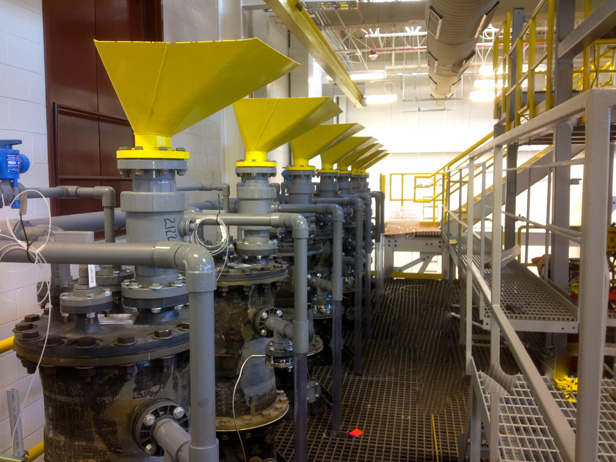Cellulosic Ethanol Gets a $100 Million Boost

Despite years of federal mandates, the cellulosic biofuels industry—which aims to make ethanol from wood chips and similar plant matter instead of corn—has yet to start commercial-scale production.
But the fledgling industry got some good news yesterday when Virdia, a company that converts cellulose into sugar, announced that it had raised over $100 million in private and public financing to go toward building its first commercial-scale plant. Converting cellulose to sugar is the most difficult part of making cellulosic biofuels. Once the sugars are produced, they can be converted to ethanol using the conventional process for making ethanol, which uses corn sugar.
Wood chips and other cellulosic materials have several advantages: they’re abundant, they don’t compete with food crops like corn, and they result in far lower carbon-dioxide emissions than corn ethanol.
Philippe Lavielle, Virdia’s CEO, says the company’s technology, when employed at a large scale, could make cellulosic sugars economically competitive with sugar made from corn. “A corn ethanol plant could use sugars from Virdia instead of corn sugar,” he says.
Virdia, which until today was called HCL Cleantech, grinds up wood chips and cleans them to remove contaminants, then dissolves the cellulose and hemicellulose components with hydrochloric acid, in a process called acid hydrolysis. That leaves behind a brown powdery substance called lignin that can be used in wood pellet stoves, or could be used to make other fuels and useful chemicals.
Acid hydrolysis is an old process, but it has been too expensive to be used to produce cheap sugar. Virdia’s key innovation is a proprietary process for inexpensively recycling the acid, which makes acid hydrolysis cheaper and cleaner. “The 70-year-old process never recycled hydrochloric acid, it just neutralized it. That made it uneconomical and difficult to justify environmentally, because it produced mountains of salt,” Lavielle says.
The company says another advantage of its technology is that it produces more sugar per ton of biomass than conventional approaches, which typically rely on breaking cellulose down with enzymes. It produces between 95 and 97 percent of the theoretical maximum, compared to 75 to 80 percent with enzyme-based approaches, Lavielle says. “We get all the sugars out from brute-force engineering,” he says.
Virdia’s funding includes $20 million in venture capital equity and $10 million in a venture debt, which will go toward continued operations at the company’s pilot plant, and funding the development of 50,000- and 150,000-ton-per-year demonstration plants. The state of Mississippi has provided a $75 million low-interest loan package to fund construction of a plant in the state. It has also offered $155 million in tax incentives.
The money is not enough to build a commercial-scale plant that could produce competitively priced sugar, Lavielle says. “It’s a good start,” he says, “but it takes more than that. It takes a chemical firm that will want to build it to have access to sugars for their own conversion processes.”
Lavielle estimates that it will cost $380 million to build a commercial plant that can produce 500,000 tons of sugar per year, enough to supply a 25-million-gallon ethanol plant, the size of a small conventional ethanol plant. The cost could be much less, however, if the plant can be located near a paper mill or chemical plant, so that it could use existing power infrastructure or wood-handling equipment from a paper mill. Lavielle estimates it could be two to three years before such a plant can be built.
Lavielle says the company calculates that it can compete with corn sugar provided corn costs more than $4 a bushel—it’s about $6.50 a bushel now, driven by high demand. But there’s a chance corn prices will fall below $4 a bushel or lower, where it has been in the past.
The calculations include revenues—eight cents per ton—from selling the lignin to be burned in wood stoves. The economics get better if the company can sell the lignin as a source for higher-value products, such as liquid fuels or chemicals. The process also produces a type of sugar called xylose, which is derived from the hemicellulose part of wood chips. The current cost calculations don’t include sales of xylose, which is often used in chewing gum and toothpaste. Lavielle says such sales could significantly boost revenues.
But the overall cost estimates also assume there’s a large supply of wood chips nearby. It will still be cheaper to use corn in areas where corn is plentiful, but wood chips aren’t. One of the remaining challenges with cellulosic biofuels is that wood chips and grasses are bulky and costly to ship.
Keep Reading
Most Popular
Large language models can do jaw-dropping things. But nobody knows exactly why.
And that's a problem. Figuring it out is one of the biggest scientific puzzles of our time and a crucial step towards controlling more powerful future models.
The problem with plug-in hybrids? Their drivers.
Plug-in hybrids are often sold as a transition to EVs, but new data from Europe shows we’re still underestimating the emissions they produce.
Google DeepMind’s new generative model makes Super Mario–like games from scratch
Genie learns how to control games by watching hours and hours of video. It could help train next-gen robots too.
How scientists traced a mysterious covid case back to six toilets
When wastewater surveillance turns into a hunt for a single infected individual, the ethics get tricky.
Stay connected
Get the latest updates from
MIT Technology Review
Discover special offers, top stories, upcoming events, and more.